
Volume
28, No. 1 – January 2015
Volume 28, No. 1
Editor: Stephen L. Seftenberg
Website:
www.CivilWarRoundTablePalmBeach.org
The President’s Message
Dues are due. Elections will be held in
January. If you wish to run for any office or serve on the Board or any
committee, please call me (561 967-8911) or e-mail me
(honeybell7@aol.com).
Gerridine LaRovere, President
January 14, 2015 Program
Steven Stanley, Map Designer for the Civil War Trust,
lives in Gettysburg and is a graphic artist specializing in historical
map design and battlefield photography. His maps, considered among
the best in historical cartography, have been a longtime staple of the
Trust and have helped raised millions of dollars for the Trust through
their preservation appeals and interpretation projects. He is
co-author with J. D. Peatruzzi of three books: The Complete Gettysburg
Guide, The New Gettysburg Campaign Handbook, and The Gettysburg Campaign
in Numbers and Losses. Stanley and Petruzzi are working on a
similar trilogy for Antietam. Stanley, James Kessler, and Wayne
Motts are also working on Pickett’s Charge at Gettysburg: A Guide to
the Most Famous Attack in American History. Stanley will talk
about the history of Civil War mapping and then go into how he creates
Civil War maps for books, the Hallowed Ground magazine and the
Trust.
December 10, 2014 Program:
Robert Macomber, The Global Civil War
Mr. Macomber, here for his 12th Holiday visit, started by stating
that there have been innumerable civil wars in history, but few have
been "international" wars. He cited the English Civil War in the 16th
century, the French Civil War in the 17th century, the Spanish Civil
Wars in the early 19th century, and the American Civil War in the 19th
century. The legacy of our Civil War exists around the world today.
In the American Revolution, the American rebels wanted to bring the
war to the British, but were obviously unable to match British naval
power head on. So we resorted to "guerre de course" or commerce
raiding, a kind of guerrilla war of attrition at sea aimed at British
commerce. Few countries depended upon international commerce to the
extent the British did. John Paul Jones is the "face" of this war, but
the American rebels sent raiders all over the globe. The same strategy
was employed in the War of 1812. In both these wars, the raiders’ top
target was: oil! Whale oil provided lubrication and illumination. To
illustrate how persistent a policy, once adopted, can be, until 1890,
the U. S. Navy, faced with the fact of British primacy at sea, followed
guerre de course as official policy and built ocean raiders!
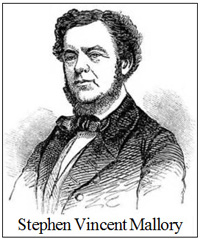 When the war started in 1861, the U. S. Navy had 65 ships in
commission – one-third were out of service being repaired, one-third
were in transit and one-third were actually in service. Only 12 ships
were on active duty in home waters and 5 were in two overseas squadrons. Suddenly, the North was faced with the reverse of the situation America
faced in the two wars with Britain. The effectiveness of the
Confederacy’s policy of guerre de course is all due to two men: Stephen Mallory (1812-1873), the Confederate Secretary of the Navy and
Judah P. Benjamin (1811- 1884). the Confederate Secretary of State. Born
in Trinidad, Mallory’s father moved to Key West, Florida, but then died,
leaving his widow to raise two boys. Mallory became well-known as an
admiralty lawyer. Elected to the U. S. Senate in 1851 when the
"establishment" Democrats had a falling out with David Yulee, Mallory
worked his way up the Senate ladder. As Chair of the U. S. Senate Naval
Affairs Committee, in 1853, his committee added 6 new screw frigates to
the fleet – considered the best frigates in the world. In 1857, his
committee added 12 new sloops-of-war. which entered the navy beginning
in 1858. Without these vessels, the plight of the U. S. Navy in 1861
would have been even more parlous. When the war started in 1861, the U. S. Navy had 65 ships in
commission – one-third were out of service being repaired, one-third
were in transit and one-third were actually in service. Only 12 ships
were on active duty in home waters and 5 were in two overseas squadrons. Suddenly, the North was faced with the reverse of the situation America
faced in the two wars with Britain. The effectiveness of the
Confederacy’s policy of guerre de course is all due to two men: Stephen Mallory (1812-1873), the Confederate Secretary of the Navy and
Judah P. Benjamin (1811- 1884). the Confederate Secretary of State. Born
in Trinidad, Mallory’s father moved to Key West, Florida, but then died,
leaving his widow to raise two boys. Mallory became well-known as an
admiralty lawyer. Elected to the U. S. Senate in 1851 when the
"establishment" Democrats had a falling out with David Yulee, Mallory
worked his way up the Senate ladder. As Chair of the U. S. Senate Naval
Affairs Committee, in 1853, his committee added 6 new screw frigates to
the fleet – considered the best frigates in the world. In 1857, his
committee added 12 new sloops-of-war. which entered the navy beginning
in 1858. Without these vessels, the plight of the U. S. Navy in 1861
would have been even more parlous.
When Florida seceded, Mallory joined the fledgling Confederacy. President Jefferson Davis appointed him Secretary of the Navy in March
1861. Mallory knew the South would never be able to go "ship-to-ship"
against the U.S. Navy, so he adopted a naval strategy (supplementing the
strategy used against England in the American Revolution and the War of
1812) based on the following strategies:
(1) Deploying sea-going commerce raiders to disrupt Union
merchant shipping and divert Union warships from the blockade to
chase the raiders.
(2) Running the Union blockade using a combination of private
shipping and specially-constructed blockade-running ships operated
by the Confederate Navy.
(3) Fighting on the rivers to keep the Confederacy from being
split in two and severing its supply lines from West of the
Mississippi.
(4) Adopting and deploying emerging naval technologies
(ironclads, submersibles, and torpedoes) to attempt to keep southern
harbors, especially Norfolk, Wilmington, Charleston, Mobile ,and New
Orleans, open and maintain the flow of supplies through the
blockade.
Macomber’s talk focused on the first two of these strategies.
Initially, the Confederates tried commerce raiding by issuing "Letters
of Marque" to allow private parties to act as raiders on behalf of the
Confederate government. Due to international treaty and an inadequate
response from private ship owners, the Confederate Navy soon took over
purchasing sea-going ships to prey on Union commerce shipping and whale
hunting. These would be regular, commissioned war ships. While some of
these had great success (notably the CSS Alabama., CSS Florida,
and CSS Shenandoah), they failed to even partially disable
Union maritime commerce, although they did contribute to the eventual
demise of the U.S. merchant marine industry because of the inflation in
insurance costs. They were only partially successful at diverting Union
Navy ships off the blockade to try to hunt them down and capture them.
Blockade running was also initially entrusted to private parties, but
the private runners ultimately failed to deliver the war material needed
by the Confederacy to prosecute the war. The demand for luxury goods
(and the willingness of the Confederate aristocracy to pay whatever
price was demanded) made it more lucrative for private runners to carry
cargo to meet this demand, despite government requirements that they
carry a certain percentage of military cargo. Eventually, the
Confederate Navy chose to construct and crew its own blockade runners in
order to supply arms and equipment to the armies of the Confederacy.
Mallory embraced the use of ironclad ships as a means of going up
against the overwhelming firepower of the big frigates and sloops of the
Union Navy. The use of submersible vessels (the "Davids" and CSS
Hunley) did not achieve widespread success, and the use of
torpedoes, while effective in the latter stages of the war (in terms of
both real results and their psychological impact), failed to stem the
Northern tide.
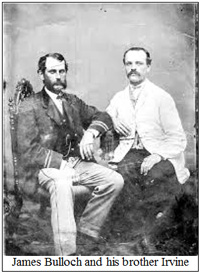 In pursuit of building a navy from scratch, Mallory sent a very
talented man, James Bulloch (1825-1901), to England and to use
Confederate cotton to purchase ocean raiders and blockade runners. Bulloch had served in the United States Navy for 15 years before
resigning his commission to join a private shipping company in 1854. When the war started, Bulloch wanted to be an ocean raider himself. After all, ocean raiders had "fun" blowing stuff up, burning things down,
and making money off prizes without killing many people in the process. Instead, he became a Confederate secret agent and their "most dangerous
man" in Europe according to the Northern State Department officials. In pursuit of building a navy from scratch, Mallory sent a very
talented man, James Bulloch (1825-1901), to England and to use
Confederate cotton to purchase ocean raiders and blockade runners. Bulloch had served in the United States Navy for 15 years before
resigning his commission to join a private shipping company in 1854. When the war started, Bulloch wanted to be an ocean raider himself. After all, ocean raiders had "fun" blowing stuff up, burning things down,
and making money off prizes without killing many people in the process. Instead, he became a Confederate secret agent and their "most dangerous
man" in Europe according to the Northern State Department officials.
Less than two months after the attack on Fort Sumter, Bulloch
established a base of operations in Liverpool. Britain was officially
“neutral” in the conflict between North and South, but private and
public sentiment favored the Confederacy. Britain was also willing to
buy all the cotton that could be smuggled past the Union blockade, which
provided the South with its only real source of hard currency. Bulloch
arranged for the construction and secret purchase of the commerce
raiders CSS Alabama and CSS Florida as well as many of the blockade
runners that acted as the Confederacy's commercial lifeline. James’s
brother, Irvine Bulloch, would serve and fight on CSS Alabama. James
also purchased a large quantity of ordnance and naval supplies, bought a
steamship SS Fingal, renamed it CSS Atlanta, filled it with this
material, and captained it to America. Bulloch returned to England
and was involved in constructing and acquiring a number of other
warships and blockade runners for the Confederacy, including purchasing
Sea
King, which was renamed CSS Shenandoah. Bulloch instructed Captain
James Iredell Waddell (1824-1886) to sail CSS Shenandoah “into the seas
and among the islands frequented by the great American whaling fleet, a
source of abundant wealth to our enemies and a nursery for their seamen.
It is hoped that you may be able to greatly damage and disperse that
fleet.” CSS Shenandoah fired the last shots of the war on June 28, 1865
during a raid on American whalers in the Bering Sea. More about this
later in Macomber’s talk.
Gideon Welles, the Northern Secretary of the Navy, faced a terrible
job. Europe favored the South for two reasons: (1) to keep cotton
flowing to its mills and (2) to undermine America’s rise as a world
power. No wonder he and his naval officers were not enthusiastic about
General-in-Chief Winfield Scott’s “Anaconda Plan.” After all, how was the
U. S. Navy, with only 65 ships, to cover over 5,000 miles of coast line? For the first two years of the war, the Northern blockade was extremely
porous. However, the North energetically built up the U. S. Navy. By the
end of the war there were 632 U. S. Naval vessels afloat. Americans have
built huge navies virtually from scratch three times in our history:
Civil War, World War I, and World War II. Before Fort Sumter, the Navy
had been kept on short rations because Congress did not trust it – in
England, the aristocratic Navy had encroached on Parliament’s powers. The first American admiral wasn’t appointed until 1862 and even then as
an “acting” Rear Admiral. The U. S. Navy also had to develop fleet
tactics from scratch. Macomber said he religiously avoids “taking sides”
between North and South, but that he clearly prefers Mallory, who was
personable and humorous, to Welles, who was neither.
 Macomber then turned to Judah P. Benjamin, one of his favorite guys and,
incidentally, one of the few living people to have their portrait on a
Confederate Two Dollar Bill! Benjamin spoke several languages, could
“schmooze” everybody. In 1861 he persuaded England and France to
recognize the Confederacy as a “legitimate belligerent,” which meant
that the South’s ocean raiders would not be treated as pirates and
“enemies of all nations.” England and, to a lesser degree France, made
lots of money off the Civil War. Britain allowed nearly all the ocean
raiders and blockade runners to be build in British shipyards in blatant
violation of its “neutrality.” The design of the ocean raiders was
“state of the art” and they were armed with Armstrong rifled cannon,
placed in both pivots, and broadsides. The South sent its “best and
brightest” officers to command these vessels. Macomber next introduced
us to two of the best and the brightest: Macomber then turned to Judah P. Benjamin, one of his favorite guys and,
incidentally, one of the few living people to have their portrait on a
Confederate Two Dollar Bill! Benjamin spoke several languages, could
“schmooze” everybody. In 1861 he persuaded England and France to
recognize the Confederacy as a “legitimate belligerent,” which meant
that the South’s ocean raiders would not be treated as pirates and
“enemies of all nations.” England and, to a lesser degree France, made
lots of money off the Civil War. Britain allowed nearly all the ocean
raiders and blockade runners to be build in British shipyards in blatant
violation of its “neutrality.” The design of the ocean raiders was
“state of the art” and they were armed with Armstrong rifled cannon,
placed in both pivots, and broadsides. The South sent its “best and
brightest” officers to command these vessels. Macomber next introduced
us to two of the best and the brightest:
 Raphael Semmes (1809-1877) was an officer in the United States Navy
from 1826 to 1860 and in the Confederate States Navy from 1860 to 1865. He was captain of the famous commerce raider CSS Alabama, Between August
1862 and June 1864, he took a record 86 prizes in the Caribbean Sea, North Atlantic, South Atlantic, Indian, and Pacific Oceans. Welles
sent many “flying squadrons” in futile effort to destroy or capture him. Welles, seriously embarrassed by this, wanted Semmes hung as a pirate. Finally, Semmes is trapped in Cherbourg, France and
CSS Alabama is sunk.
[Editor’s note: The effort begun in 1990's to salvage the wreck is a
complicated tale of international cooperation beyond the scope of this
report.] Semmes escaped and returned to the South and was promoted to
Rear Admiral. He also served briefly as a Brigadier General in the
Confederate Army. Admiral/General Semmes is the only North American to
have the distinction of holding both ranks simultaneously. Raphael Semmes (1809-1877) was an officer in the United States Navy
from 1826 to 1860 and in the Confederate States Navy from 1860 to 1865. He was captain of the famous commerce raider CSS Alabama, Between August
1862 and June 1864, he took a record 86 prizes in the Caribbean Sea, North Atlantic, South Atlantic, Indian, and Pacific Oceans. Welles
sent many “flying squadrons” in futile effort to destroy or capture him. Welles, seriously embarrassed by this, wanted Semmes hung as a pirate. Finally, Semmes is trapped in Cherbourg, France and
CSS Alabama is sunk.
[Editor’s note: The effort begun in 1990's to salvage the wreck is a
complicated tale of international cooperation beyond the scope of this
report.] Semmes escaped and returned to the South and was promoted to
Rear Admiral. He also served briefly as a Brigadier General in the
Confederate Army. Admiral/General Semmes is the only North American to
have the distinction of holding both ranks simultaneously.
 James Newland Maffitt (1819-1886), in command of
CSS Florida, set out
in January 16, 1863 and spent 6 months off North and South America and
in the West Indies, with calls at neutral ports, all the while making
captures and eluding the Northern squadrons pursuing him. It was during
this period that he acquired the nickname "Prince of Privateers" (which
was somewhat inaccurate, since he was a naval officer and not an actual
privateer.) After yielding command of CSS Florida due to ill health, at
the end of the war he commanded CSS Owl, a successful blockade runner. Instead of surrendering his ship, he took it to England. After the war
he commanded an English merchant steamer and a warship on the rebels’
side in the Cuban Ten Years War. James Newland Maffitt (1819-1886), in command of
CSS Florida, set out
in January 16, 1863 and spent 6 months off North and South America and
in the West Indies, with calls at neutral ports, all the while making
captures and eluding the Northern squadrons pursuing him. It was during
this period that he acquired the nickname "Prince of Privateers" (which
was somewhat inaccurate, since he was a naval officer and not an actual
privateer.) After yielding command of CSS Florida due to ill health, at
the end of the war he commanded CSS Owl, a successful blockade runner. Instead of surrendering his ship, he took it to England. After the war
he commanded an English merchant steamer and a warship on the rebels’
side in the Cuban Ten Years War.
Macomber then introduced us to Charles William Read (1840-1890),
class of 1860, U.S. Naval Academy. Read exhibited bravado and leadership
from the beginning of the war. He participated in the attack on the
Union blockading squadron at Head of the Passes on the Mississippi
River. When the commander of CSS McRae was wounded, Read took command of
the ship. Read then served as executive officer of CSS Arkansas during
its fight with over 30 Northern ships blockading the Mississippi River
near Vicksburg, Mississippi and served as its acting commander in her
final battle assaulting Baton Rouge, Louisiana. After the sinking of
Arkansas, Read was assigned to the CSS Florida. When Maffitt captured the
USS Clarence in Brazilian waters, Read persuaded him not to sell it but
to put him in command so he could raid the East Coast from Norfolk,
Virginia to Portland, Maine. Imagine a 23-year old ensign commanding 16
sailors and armed with one 6-pound boat howitzer and 2 “Quaker” fake
guns, planning to sail into the biggest naval base in the US and raise
havoc. Sailing North from Brazilian waters, Maffitt targets New York
City. Outside the harbor, he destroys two merchant ships. Meanwhile, by
sheer coincidence, Read in CSS Clarence is sailing along the north coast
of Long Island.
Their efforts were not planned but were brilliantly successful,
causing pandemonium among shipping circles with consequences with us
today. Besieged by complaints from insurance companies, shipping line
owners, the fishing industry, and chambers of commerce, Welles has the US
Navy desperately searching for CSS Florida but cannot find her because
Maffitt had sailed her to Bermuda to refit and refuel. Insurance rates
are skyrocketing and the merchant fleet is staying in port. According to
the New York Chamber of Commerce, by mid-1863, 150 vessels and 150 tons
worth $12 million have been captured by Confederate raiders world wide. Rather than remaining idle, merchants ships are being registered under
foreign flags or sold to British owners. Before the Civil War, the
American merchant marine had been the largest in the world. That ended
permanently in 1863!
During this raid, Lieutenant Read captured or destroyed 22 U.S.
vessels. The Northern Navy thought the raid involved a whole fleet
of Confederate ships, because, if a captured vessel was bigger or faster
or better armed, Read transferred his crew and supplies, first to CSS Tacony and finally to
CSS Archer, and would then sink his old vessel. Moreover, Read’s raid came at a fortuitous time – in New York, the draft
riots were on and blacks were being lynched; Gen. Robert E. Lee had
invaded the North and the Northern generals had lost track of him –
perhaps his target was Washington, D. C. or even New York! All of this
was sheer coincidence, but the Northern mercantile interests smelled a
real threat.
Read and his crew were captured off Portland, Maine, while attempting
to take USRC Caleb Cushing, not by the U.S. Navy, but by the local
militia. Those troops commandeered the unarmed Forest City, manhandled a gun aboard,
and took off after Read. Read, who cannot fire back for lack of powder, finally surrenders. The militia saved Read and his men from a mob who
wanted to lynch them as pirates. Read was held at Fort Warren,
Massachusetts, until he was exchanged on October 18, 1864, for a U. S.
Naval officer.
Read’s contribution to history exceeds any possible expectation. Northern maritime commerce was completely disrupted even after he was
captured because the North believed other Confederate raiders were still
at large. Insurance rates continued to escalate. The U. S. merchant
marine lost only 22 ships but shrank by 40% and has never recovered.
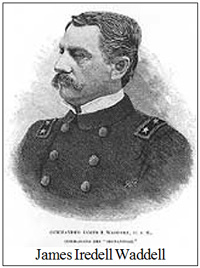 Macomber’s final vignette was of James Iredell Waddell (1824-1886),
who commanded CSS Shenandoah. Waddell, not knowing the South had
surrendered and the war was over, continued to harass the Northern
whaling fleet until September 1865, when he sailed toward Fort Alcatraz
to refit and refuel. On the way he stopped a British whaler who showed
him a newspaper saying the war is over. If he and his crew did not
surrender immediately they would truly be deemed to be pirates. Waddell
huddled with his men and all decided not to surrender in California but
to sail 9,000 miles back to Liverpool. They could not stop at any ports
on the way and subsisted on fish and rainwater, arriving in Liverpool on
November 7, 1865. Waddell refused to take a harbor pilot on board and
instead dropped anchor next to a British frigate. He “decommissioned”
his ship and then surrendered to the Lord Mayor of Liverpool. A big
legal too-do followed, with the American Ambassador demanding they be
arrested and tried as pirates. Instead a British court held that as
“legitimate belligerents” they could not be arrested. Shenandoah was
eventually sold to a British firm. Macomber’s final vignette was of James Iredell Waddell (1824-1886),
who commanded CSS Shenandoah. Waddell, not knowing the South had
surrendered and the war was over, continued to harass the Northern
whaling fleet until September 1865, when he sailed toward Fort Alcatraz
to refit and refuel. On the way he stopped a British whaler who showed
him a newspaper saying the war is over. If he and his crew did not
surrender immediately they would truly be deemed to be pirates. Waddell
huddled with his men and all decided not to surrender in California but
to sail 9,000 miles back to Liverpool. They could not stop at any ports
on the way and subsisted on fish and rainwater, arriving in Liverpool on
November 7, 1865. Waddell refused to take a harbor pilot on board and
instead dropped anchor next to a British frigate. He “decommissioned”
his ship and then surrendered to the Lord Mayor of Liverpool. A big
legal too-do followed, with the American Ambassador demanding they be
arrested and tried as pirates. Instead a British court held that as
“legitimate belligerents” they could not be arrested. Shenandoah was
eventually sold to a British firm.
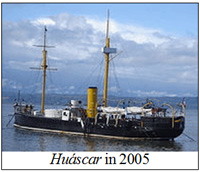 Macomber pointed out that Confederate crews were an international lot
– Brits, French, Australians, Brazilians, and sometimes even Union
sailors serving on ships captured by the ocean raiders. Today,
Confederate graves are tended in Brazil and Australia by the United
Daughters of the Confederacy. Only one Civil War era vessel still
exists, Huáscar, restored and maintained as a memorial to the Peruvian
and Chilean Navies in Talcahuano Naval Base, Chile. Macomber pointed out that Confederate crews were an international lot
– Brits, French, Australians, Brazilians, and sometimes even Union
sailors serving on ships captured by the ocean raiders. Today,
Confederate graves are tended in Brazil and Australia by the United
Daughters of the Confederacy. Only one Civil War era vessel still
exists, Huáscar, restored and maintained as a memorial to the Peruvian
and Chilean Navies in Talcahuano Naval Base, Chile.
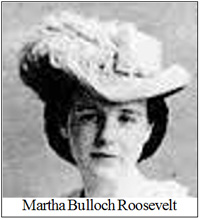 James Bulloch, the Confederate purchasing agent in Britain, had
another interesting effect on American history. His sister, Martha
“Mittie” Bulloch, a real Southern belle, married Theodore Roosevelt,
Sr., father of Theodore Roosevelt, Jr., who disliked being called
“Teddy.” Scarlet O’Hara of Gone With the Wind fame is reputed to have
been modeled on Mittie. After TR’s father died, TR spent lots of time
with his uncle, James Bulloch, who taught him about naval strategy,
especially in the War of 1812. This inspired TR to write The Naval War
of 1812 , published when he was only 24. TR also studied Captain Mahan’s
The Influence of Sea Power on History. It is no accident that TR, as
Assistant Secretary of the Navy, implemented updated strategy and fleet
tactics and fostered a modern navy that replaced the British Navy as the
world’s dominant sea power. Nor is it an accident that TR’s cousin,
Franklin Delano Roosevelt, also served in the same post. James Bulloch, the Confederate purchasing agent in Britain, had
another interesting effect on American history. His sister, Martha
“Mittie” Bulloch, a real Southern belle, married Theodore Roosevelt,
Sr., father of Theodore Roosevelt, Jr., who disliked being called
“Teddy.” Scarlet O’Hara of Gone With the Wind fame is reputed to have
been modeled on Mittie. After TR’s father died, TR spent lots of time
with his uncle, James Bulloch, who taught him about naval strategy,
especially in the War of 1812. This inspired TR to write The Naval War
of 1812 , published when he was only 24. TR also studied Captain Mahan’s
The Influence of Sea Power on History. It is no accident that TR, as
Assistant Secretary of the Navy, implemented updated strategy and fleet
tactics and fostered a modern navy that replaced the British Navy as the
world’s dominant sea power. Nor is it an accident that TR’s cousin,
Franklin Delano Roosevelt, also served in the same post.
Macomber closed his fascinating talk with an exploration of the
problems facing the Confederate ocean raids once they captured a
merchant or whaling ship. For example, when CSS Alabama, took a
prize off the coast of Vietnam, there was no port and no admiralty court
to award prize money, Semmes burned the prize ship. An
alternative would be to put the captured seamen on board the prize,
"parole" the ship, have its captain sign a "bond" on behalf of the
owners and order him to sail to a port that had a court where the ship’s
owners were supposed to pay off the bond to the Confederates States of America.
Macomber doubted that many of these bonds were actually paid off.
The audience gave Robert Macomber a well-earned round of applause for
an entertaining talk.
Last changed: 01/08/15
Home
About News
Newsletters
Calendar
Memories
Links Join
|

